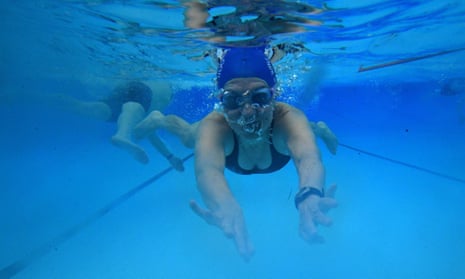
England has lost almost 400 swimming pools since 2010
Analysis shows parts of country with greatest health-related deprivation have lost out the most
England has lost almost 400 swimming pools since 2010, with parts of the country that have the greatest health needs losing out the most.
The national body for swimming said there was “an urgent need to invest” in England’s pools, after new figures revealed that the pandemic had accelerated a decade of decline in aquatic facilities.
Guardian analysis of data collected by Sport England found a net decline of 382 swimming pools across the country since 2010. These figures include local authority- and community-owned pools, privately run health facilities, schools and sports clubs. The loss of pools has led to an estimated £1bn loss of associated social value through health and community benefits.
The number of pools in council areas with the highest levels of health-related deprivation fell by 14% over the last 12 years, while those in the least health-deprived areas fell by 6%, the analysis shows.
Hartlepool, one of the most health-deprived areas in the country, has seen six of its 12 pools close over the last 12 years. Three were at schools and the other three were at gyms or community centres.
While the number of swimming pools in England has been falling since the Conservative government came to power, the pandemic and the surging cost of energy have accelerated the trend.
Across the country, 85 pools have been closed and not replaced since 2019. The number closing due to financial reasons – either because of insolvency or the facilities being unprofitable – has doubled compared with in the three years before the pandemic.
Brighton and Hove lost four pools since 2019, more than any other local authority in the same period. Three were lost during the closure of Virgin Active in 2021 and one when Sports Direct Fitness in Hove closed in 2022.
The sports body UK Active has called for the government to extend its energy bills discount scheme to leisure centres by recognising them as intensive energy users. Current energy costs relief will come to an end at the end of March, leaving many facilities at risk. According to the body, 31% of council areas in England are at risk of losing their leisure centres or seeing reduced services from 1 April.
READ RELATED: Here's What Cardi B & Offset's McDonald's Order Actually Looks Like
Local government spending figures show that net expenditure on sports and leisure facilities in England fell by 37% between 2010-11 and 2021-22 in real terms.
Thanks to improved physical and mental health, and individual, social and community development, swimming activities in leisure centres generated about £375,000 in social value per site last year, according to estimates from the sports and data consultancy 4Global. Applied to the pool closures since 2010, this works out as more than £1bn of lost social benefits.
A Swim England spokesperson said it was vital there were appropriate facilities in the right locations, and they called for more government support.
They said: “Across the country, many pools are coming to the end of their lifespan or have already closed, and soaring energy costs are placing many more at risk of closure or service reductions. There is therefore an urgent need to invest in providing the pools our communities need.
“We have set out a vision for the future of facilities which can be more sustainable, but making it a reality requires support from the government. The proposed new sports strategy needs to set out a plan for growth to unlock the potential of pools and leisure centres to support the … health and wellbeing of the nation.”
Swimming pools are not the only kind of sports facility to have witnessed a decline since 2010. The number of squash courts has fallen by 20% over the same period, and 13% of indoor bowls facilities have also been lost.
On the other hand, cycling facilities and artificial grass pitches have seen dramatic increases since 2010, and the number of gyms has steadily risen. The data in the Guardian’s analysis was pulled from a live database, so recent records on sports facility closures may change as records for individual centres are updated.
A government spokesperson said: “We know our grassroots sports facilities are contending with increases in running costs. We provided an £18bn package of support for organisations including clubs, pools, leisure centres, schools, charities and businesses through the winter.
“We made £1bn available to ensure the survival of sports and leisure sectors during the pandemic, giving councils an additional £3.7bn to deliver key services such as leisure centres and swimming pools, and we are investing £300m to build or upgrade thousands of grassroots facilities across the UK.”
Source: Health & wellbeing | The Guardian








